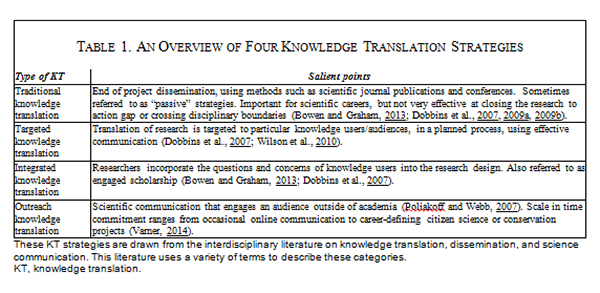Christina Holmes Ph.D. Dalhousie Universit
Fiona McDonald Ph.D. Dalhousie University
Mavis Jones Ph.D. Dalhousie University
Janice Graham Ph.D. Director of TRRU Dalhousie University
Moving Proteomics Science to Innovation in Society
Research cumulatively builds knowledge. In the omics sciences, a prerequisite to knowledge building is acknowledging the interconnected nature of its fields. The evolution of complex biomedical knowledge has seen increasing diversity together with disciplinary specialization, and a growing need for these disciplines to work together, along with nonscientists knowledgeable about policy and applications, to solve the persistent challenges humans face. At the same time, specialization drives communicative and perceptive wedges between these different fields, disciplines, and sectors, making collaboration a challenge. Given the persistence of these collaborative challenges and the importance of the objectives that these different disciplines are hoping (and in some cases, committed) to achieve, it is little surprise that an area of specialization has emerged to order the chaos. In this context, knowledge translation (KT) is the practice of turning the multidisciplinary evidence generated by scientific discovery into actions and outcomes—through, for example, the generation of recommendations for clinical applications, realignment of funding agenda, and priorities, service and program planning, and policy or regulatory reforms.
KT, as a specific field of research into the process of how knowledge is translated, was originally applied primarily to the clinical practices research (Curran et al., 2011; Graham et al., 2006; Grimshaw et al., 2012). It is now applied to research more generally (National Centre for the Dissemination of Disability Research, 2005). Scientists have been concerned about distributing knowledge appropriately and effectively to knowledge users and this has long been an area of study for social and health researchers from a variety of perspectives. For example, broad and long-standing interest in the spread of knowledge and innovation is contained in the works of Popper (1962), Basalla (1967), Foucault (1980), Habermas (1984), Mayo and Hollander (1991), Gambardella (1995), and Nonaka and Takeuchi (1995) among many others.
The wide range of interest in the movement of knowledge from researchers to knowledge users is represented in works on knowledge dissemination, knowledge implementation, knowledge transfer, knowledge mobilization, and knowledge brokering, for example, depending on the specific focus of interest and disciplinary background of the authors (Graham et al., 2006; Shaxson et al., 2012).
The concept of KT was first used as a criterion for funding by the Canadian Institute of Health Research (Canadian Institute of Health Research, 2014; Graham et al., 2006). It is now used by many other funding agencies, although an international study indicates that there is considerable variation in the form of KT funding agencies expect (Tetroe et al., 2008). Part of the appeal of KT is its addressing of the widespread knowledge to action gap (Bowen and Graham, 2013), particularly in the midst of public debates about the value of research (Wilsdon et al., 2005). Grimshaw et al. (2012) discuss the persistent failure of research to translate easily into practice and policy, citing studies that suggest as little as 11% compliance with research-generated healthcare recommendations.
Funders are increasingly focused on requiring researchers to provide a plan for dissemination and translation of their results because of the social and political expectation for a return on public investment in research (Besley, 2015; Özdemir et al., 2015; Tetroe et al., 2008; Wilson et al., 2010). KT is, therefore, the conduit for both the science push to supply new information and technologies and the user demand (pull) for them; it is used to explain the relevance of findings to those who fund research, and those who are designing the programs and policies that use that new information, and it helps researchers define priorities through identifying where the need for new evidence or diagnostic or treatment tools is most urgent or relevant.
The concept of KT performs two essential functions of relevance to omics system sciences and technologies. The first is that KT tackles the thorny problem of how to strategically cross disciplinary boundaries (Dobbins et al., 2007). For omics sciences that depend on multiple disciplinary specialization, it is particularly important to connect the Big Data and computational systems of different specialties to an integrated and overarching understanding of the mechanisms underlying biological processes. Second, KT, if done well, may encourage a better general understanding of science and scientific processes—which can be a significant boon to marshalling resources such as political will.
Traditional paths of dissemination of research in scientific journals do not achieve these wider translational goals (Grimshaw et al., 2012) and funding agencies are increasingly aware of this (Tetroe et al., 2008). For example, in 2008, 45% of 33 international funding agencies surveyed required a report on communications activities and 24% required a report for decision makers (Tetroe et al., 2008). Still, traditional scientific dissemination routes—publishing or presenting results at conferences or publishing in peer-reviewed journals within one's own field—are a necessary part of an effective research practice and scientists' personal career development agenda. Considered to be the primary products conferring status and prestige in scientists' careers, these methods of dissemination have been and continue to be important (Hagstrom, 1965; Hess, 2007; Merton, 1973). Publication is often the form of dissemination upon which the most emphasis is placed, not only for the scientist's time, but also for grant funding, promotion, and other career rewards.
In this article we integrate KT theory illuminated by insights from three fields, namely, science and technology studies, public understanding of science (PUS), and science communication, to map the different forms of dissemination available to (and sometimes utilized by) proteomics scientists. From interviews with, and observations of, proteomics scientists during 5 years of proteomics conferences, we identified and analyzed the KT strategies that are currently employed in the proteomics field.
Although our analysis shows that significant attention is still focused on traditional disciplinary knowledge exchange, proteomics scientists and a scientific consortium, the Human Proteome Organization (HUPO), are paying more attention to a broader range of KT strategies, including targeted KT, integrated KT, and public outreach (Table 1). Although this is encouraging, we suggest that increasing the variety of KT strategies employed by scientists would benefit the omics sciences.
Our data suggest that proteomics scientists recognize the necessity of engaging in KT, either because funding agencies are increasingly requiring it or, given the limited pool of resources, there is a need to justify to the public, funders, or even other scientists why proteomics should be funded. We detail this perspective, along with the dissemination strategies that proteomics scientists are using.

Table 1. An Overview of Four Knowledge Translation Strategies
The complete article and its references can be accessed at Mary Ann Liebert, Inc.
OMICS: A Journal of Integrative Biology, published by Mary Ann Liebert, Inc., the only peer-reviewed forum covering all trans-disciplinary OMICS-related areas such as integrative (systems) biology and medicine, including but not limited to those specialties listed below. The above article was first published in the June 2016 issue of OMICS: A Journal of Integrative Biology with the title “Knowledge Translation: Moving Proteomics Science to Innovation in Society”. The views expressed here are those of the authors and are not necessarily those of OMICS: A Journal of Integrative Biology, Mary Ann Liebert, Inc., publishers, or their affiliates. No endorsement of any entity or technology is implied.







